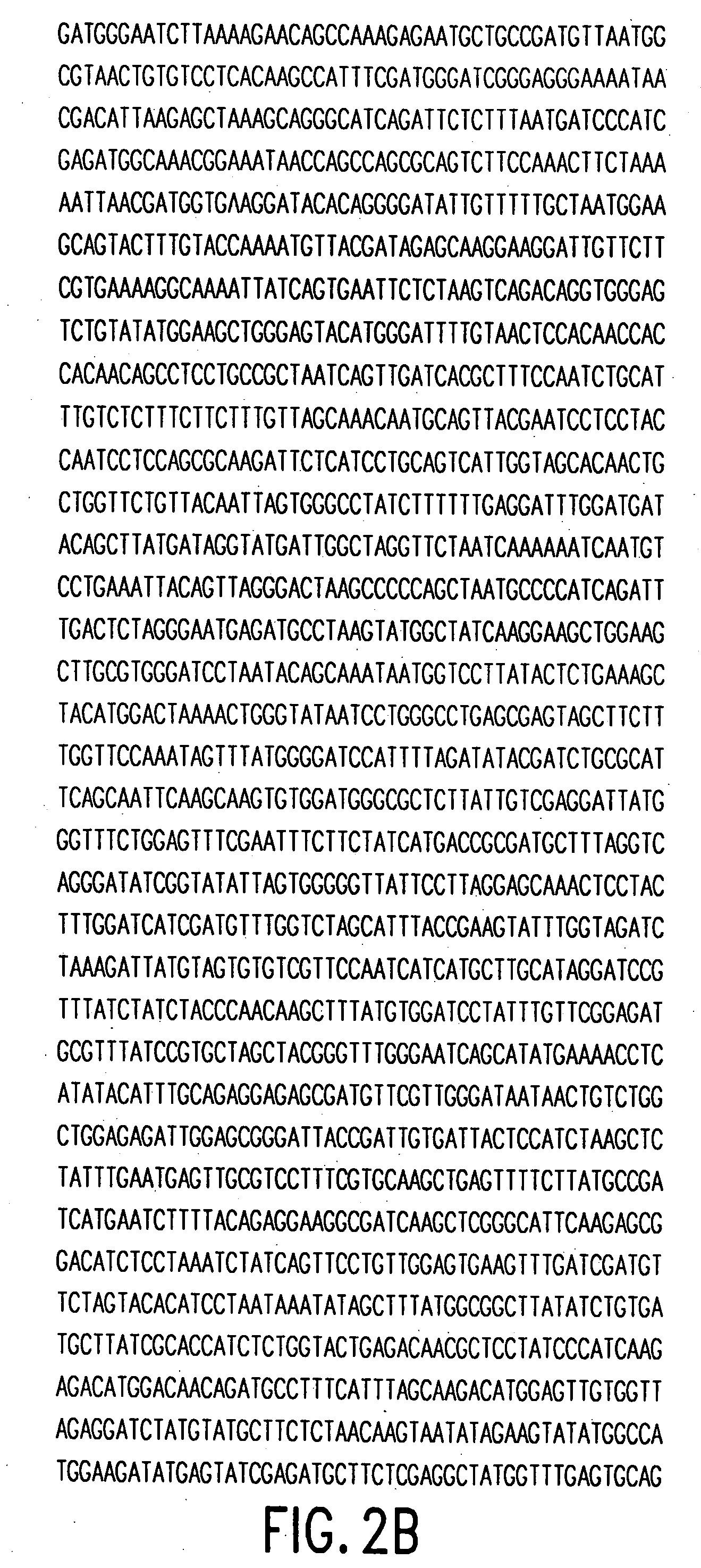Chlamydia protein, gene sequence and uses thereof
- Summary
- Abstract
- Description
- Claims
- Application Information
AI Technical Summary
Benefits of technology
Problems solved by technology
Method used
Image
Examples
example 1
[0192] Isolation and Purification of Mature Chlamydia Protein
[0193] McCoy cells were cultured either in standard 225 cm.sup.2 tissue culture flasks or in Bellco spinner flasks (Cytodex microcarrier, Pharmacia) at 37.degree. C. in 5% CO.sub.2 using DMEM media supplemented with 10% Chlamydia-antibody free fetal bovine serum, glucose and nonessential amino acids. C. trachomatis 12 elementary bodies (ATCC VR-902B) were prepared from lysates of infected McCoy cells. Basically, McCoy cells infected with C. trachomatis L.sub.2 (LGV) were sonicated and cellular debris was removed by centrifugation. The supernatant containing chlamydial elementary bodies (EBs) was then centrifuged and the pellet containing EBs was resuspended in Hanks' balanced salts solution (HBSS). RNase / DNase solution was added and incubated at 37.degree. C. for 1 hour with occasional mixing. The EB containing solution was layered onto a discontinuous density gradient (40%, 44% and 54%) of Angiovist 370 (mixture of diatri...
example 2
[0199] Preparation of Antibodies to Whole Chlamydia EBs
[0200] To aid in the characterization of the HMW protein, hyperimmune rabbit antisera was raised against whole EBs from C. trachomatis L.sub.2. Each animal was given a total of three immunizations of about 250 ug of Chlamydia EBs per injection (beginning with complete Freund's adjuvant and followed with incomplete Freund's adjuvant) at approximately 21 day intervals. At each immunization, approximately half of the material was administered intramuscularly (i.m.) and half was injected intranodally. Fourteen days after the third vaccination a fourth booster of about 100 ug of EBs was given i.m. and the animals exsanguinated 7-10 days later. A titre of 1:100,000 was obtained as determined by ELISA.
example 3
[0201] Determination of Post-translational Modifications
[0202] Recently, several C. trachomatis membrane-associated proteins have been shown to be post-translationally modified. The 18 kDa and 32 kDa cysteine-rich EB proteins, which are lectin-binding proteins, have been shown to carry specific carbohydrate moieties (Swanson, A. F. and C. C. Kuo. 1990. Infect. Immun. 58:502-507). Incorporation of radiolabelled palmitic acid has been used to demonstrate that the about 27 kDa C. trachomatis Mip-like 0.25 protein is lipidated (Lundemose, A. G., D. A. Rouch, C. W. Penn, and J. H. Pearce. 1993. J. Bacteriol. 175:3669-3671). Swanson et al. have discovered that the MOMP from the L.sub.2 serovar contains N-acetylglucosamine and / or N-acetylgalactosamine and these carbohydrate moieties mediate binding of MOMP to Hela cell membranes.
[0203] To ascertain whether the HMW protein is glycosylated, EBs are grown on McCoy cells in the presence of tritiated galactose or glucosamine, subjected to hepar...
PUM
| Property | Measurement | Unit |
|---|---|---|
| Fraction | aaaaa | aaaaa |
| Angle | aaaaa | aaaaa |
| Molecular weight | aaaaa | aaaaa |
Abstract
Description
Claims
Application Information
 Login to View More
Login to View More - Generate Ideas
- Intellectual Property
- Life Sciences
- Materials
- Tech Scout
- Unparalleled Data Quality
- Higher Quality Content
- 60% Fewer Hallucinations
Browse by: Latest US Patents, China's latest patents, Technical Efficacy Thesaurus, Application Domain, Technology Topic, Popular Technical Reports.
© 2025 PatSnap. All rights reserved.Legal|Privacy policy|Modern Slavery Act Transparency Statement|Sitemap|About US| Contact US: help@patsnap.com



